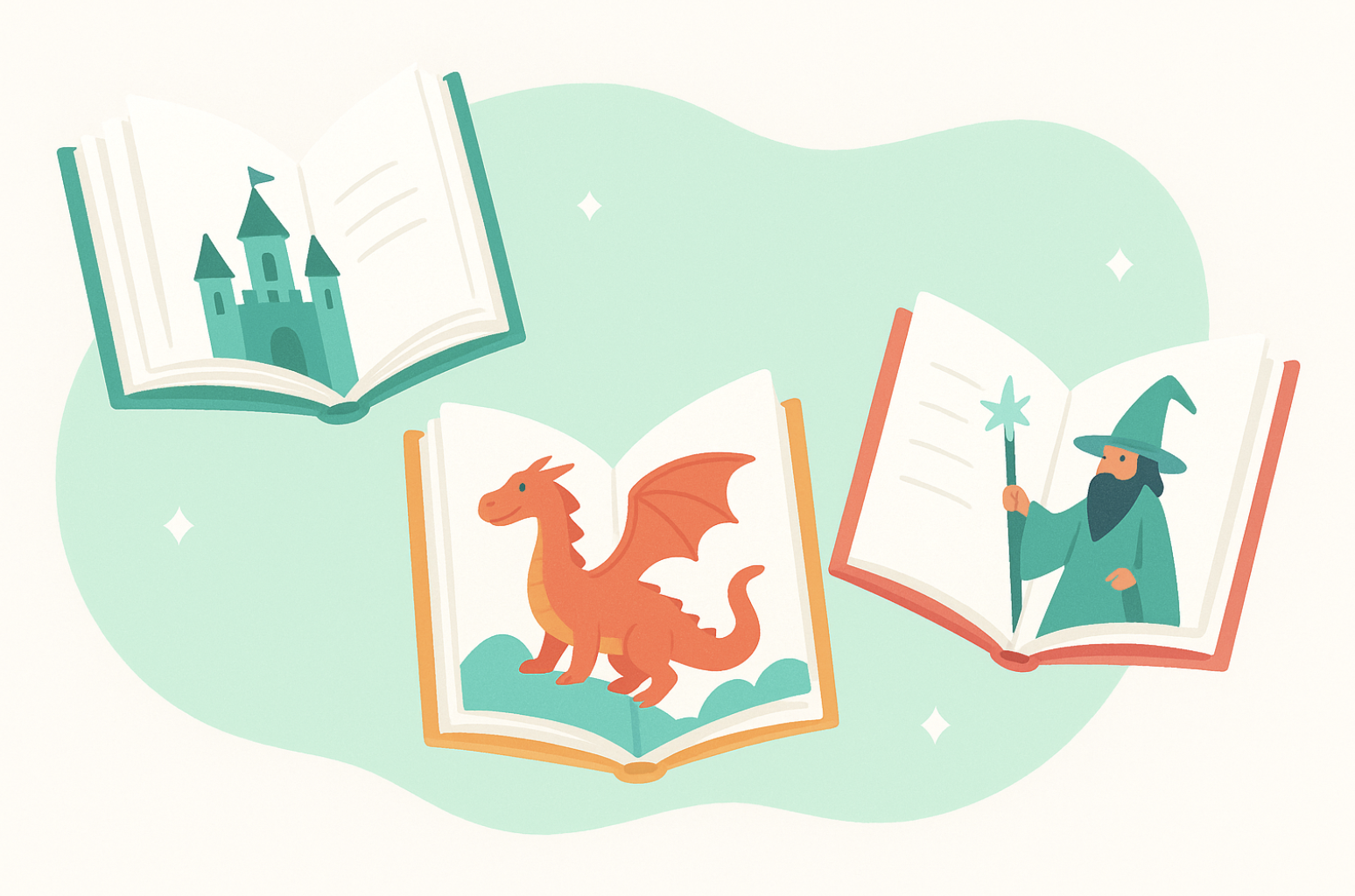What kind of story sparks a child’s imagination and keeps them turning the pages? Children’s literature is a universe of wonder, packed with magical creatures, brave heroes, everyday adventures, and questions waiting to be solved. From fairy-tale kingdoms and talking animals to real-life stories that mirror a child’s own experiences, the genres in children’s books are as diverse and limitless as the imaginations they’re written for.
Whether you have an early reader just beginning their journey or a curious explorer eager for excitement, there’s a genre that will capture their heart and open the door to discovery. These stories aren’t just about entertainment; they help young minds grow, encouraging empathy, creativity, and a lifelong love of reading.
Exploring the different children’s book genres is like giving kids a map to worlds unknown, filled with characters they’ll remember and lessons they’ll carry with them. In every genre, there’s a chance to spark joy, fuel curiosity, and plant the seeds for a lasting relationship with books.
Introduction to Children’s Literature
Children’s literature plays a vital role in a child’s development, offering more than just entertainment; it helps shape their imagination, creativity, and understanding of the world. Through reading, children strengthen essential language and literacy skills while also broadening their perspectives, developing empathy, and learning to think critically. The stories they encounter early on lay the foundation for how they engage with ideas, emotions, and people throughout their lives.
Understanding the Genres in Children’s Literature
Children’s books encompass a diverse range of genres, each with its unique style, themes, and appeal. These genres help cater to different age groups, reading levels, and personal interests, ensuring that every young reader can find stories that resonate with them. Below are some of the most popular and influential genres in children’s literature:
- Realistic Fiction: Stories grounded in real-life experiences and situations. These often explore relatable themes such as friendship, family dynamics, growing up, and emotional growth.
- Historical Fiction: Set in specific historical periods, these stories blend factual events, cultural details, and fictional characters to bring the past to life in a compelling way.
- Science Fiction: Centered around the possibilities of science and technology, this genre often features futuristic societies, time travel, space exploration, or advanced inventions, encouraging imaginative thinking about what could be.
- Fantasy: Filled with magic, mythical creatures, and imaginary worlds, fantasy stories transport readers beyond the boundaries of reality and invite them into realms of limitless possibility.
- Contemporary Fiction: These modern-day stories address current issues, challenges, and themes, such as identity, diversity, and community, helping children relate to the world around them.
- Nonfiction: Informative and fact-based, nonfiction books cover topics ranging from science and history to biographies and how-to guides. They’re perfect for curious minds eager to explore and understand the real world.
Fantasy: Realms of Magic and Imagination
Fantasy books open doors to enchanted worlds where magic is real, mythical creatures roam, and the impossible becomes everyday. From flying broomsticks to talking animals, these stories allow young readers to suspend disbelief and dive into lands of wonder. Characters like wizards, fairies, dragons, or enchanted creatures guide children through moral quests, inner growth, and dazzling adventures.
Books like Harry Potter or The Lion, the Witch, and the Wardrobe offer more than escapism; they nurture creativity, build emotional depth, and encourage kids to consider the power of courage, friendship, and belief. Fantasy helps young minds explore the “what ifs” of the world, turning curiosity into a powerful storytelling force.
Whether it’s kingdoms in the clouds or forests filled with spells, fantasy encourages children to imagine boldly, question reality, and trust in their inner magic
Adventure: Journeys Full of Challenge and Discovery
Adventure books center on action-packed quests, daring escapes, and characters who push their limits to overcome obstacles. These stories often unfold in dynamic, fast-paced settings, on land, sea, or even in space, and keep young readers on the edge of their seats.
Unlike fantasy, adventure doesn’t always rely on magic. It thrives on suspense, bravery, and real-world stakes, often involving treasure hunts, survival tales, or voyages into the unknown. From classics like Treasure Island to gripping tales like Hatchet by Gary Paulsen, where a boy must survive alone in the wilderness, adventure stories captivate readers with excitement and teach lessons about perseverance, quick thinking, and resilience.
Perfect for curious minds and thrill-seekers, the adventure genre inspires kids to explore new places, face their fears, and believe in their ability to handle whatever challenges lie ahead.
Stories That Feel Real: Everyday Life, Cultural, and Mythological Fiction
Some of the most powerful stories are those that echo real life, where the characters feel like friends and the challenges reflect what kids go through every day. These books explore emotions, friendships, family dynamics, and personal growth in ways that are easy for young readers to relate to. Whether it’s navigating school drama, facing fears, or adjusting to change, these tales serve as a comforting reminder that they’re not alone.
Books like Wonder by R.J. Palacio or Because of Winn-Dixie by Kate DiCamillo offer familiar settings and heartfelt journeys that resonate deeply, helping children build empathy, resilience, and a better understanding of themselves and others.
Complementing these grounded stories are cultural and mythological fiction books, which draw on the rich heritage of global traditions, folklore, and legends. These narratives connect young readers to different cultures and belief systems, often through tales of gods, ancestral heroes, or symbolic creatures, while fostering appreciation for diversity and storytelling history. A book like Where the Mountain Meets the Moon by Grace Lin blends fantasy with Chinese mythology, offering an imaginative journey rooted in cultural values.
Together, these stories, whether rooted in everyday reality or ancient tradition, help children connect with themselves, their communities, and the wider world, sparking both emotional growth and cultural curiosity.
Mystery and Adventure: Puzzles, Clues, and Exploration
For young readers who love a good puzzle, mystery books are the ultimate thrill! Packed with clues, hidden secrets, and unexpected twists, mystery stories pull kids into a world where every page holds a discovery waiting to be made. These tales ignite curiosity and keep young minds buzzing, encouraging readers to ask questions, make predictions, and think like detectives.
As the story unfolds piece by piece, readers sharpen their critical thinking and problem-solving skills, analyzing every clue, tracking suspicious characters, and putting together the big picture. The joy of mystery lies not just in the reveal but in the journey of solving it. From classic sleuths like Nancy Drew and The Hardy Boys to modern series like The Mysterious Benedict Society or Greenglass House, these stories offer suspense-filled adventures that grip readers from the first clue to the final reveal.
Often overlapping with the adventure genre, mystery stories also take readers on thrilling explorations into hidden passageways, mysterious mansions, secret codes, or even entire new cities. The excitement isn’t only in what’s discovered but in how it’s uncovered. Each chapter is a challenge, each character a potential key, and each twist a fresh opportunity to figure things out.
These books allow kids to become part of the story, investigating at their own pace and feeling the satisfaction of cracking the case. Mystery and adventure together create an immersive reading experience that encourages persistence, curiosity, and the joy of intellectual exploration.
History Fiction: Stories Set in the Past
History fiction opens a door to the past, allowing young readers to explore different eras, cultures, and events through vivid and immersive storytelling. By weaving fictional characters and plots into real historical settings, this genre transforms facts and timelines into powerful, relatable narratives filled with bravery, resilience, and discovery.
More than just dates and facts, history fiction helps children feel the past, what it might have been like to live through wartime, explore a new frontier, or experience life in ancient civilizations. These stories spark curiosity and empathy, encouraging young readers to consider who they might have been and how they might have acted in another time.
Books like Number the Stars by Lois Lowry or Little House on the Prairie by Laura Ingalls Wilder allow kids to step into the shoes of characters navigating real historical moments, bringing the past to life in a personal and engaging way. Biographies and autobiographies can also enhance the experience, offering insight into the real lives behind the history and making the events even more tangible.
History fiction helps bridge the gap between past and present, turning historical learning into an emotional journey. It encourages children to ask big questions, understand different perspectives, and see the relevance of history in their own lives today.
Science Fiction: Imagining the Future, Exploring the Unknown
Science fiction takes young readers on thrilling journeys through time, space, and imagination. This genre is all about what could be, from high-tech gadgets and interstellar travel to robots, aliens, and futuristic worlds that stretch the boundaries of reality.
At its heart, science fiction invites kids to wonder: What if? What if animals could talk? What if we lived on Mars? What if time machines existed? These stories blend scientific concepts with imaginative storytelling, helping young readers think critically, dream big, and explore the future through creative lenses.
Books like The Wild Robot by Peter Brown or A Wrinkle in Time by Madeleine L’Engle offer exciting plots full of adventure while introducing big ideas like artificial intelligence, space-time, and survival in unfamiliar worlds. Science fiction not only entertains, it encourages curiosity about technology, innovation, and the world’s future.
For kids who love asking questions and thinking outside the box, science fiction is a gateway to discovery. It inspires them to see beyond what is and imagine what could be, one page-turning possibility at a time.
Poetry and Folk Tales: Rhythm and Tradition
Poetry and folk tales infuse children’s literature with rhythm, tradition, and cultural wisdom. These genres captivate young readers through lyrical language, vivid imagery, and timeless themes that transcend generations.
Poetry, with its rhymes, repetition, and playful use of sound, introduces children to the musicality of language. It invites them to explore the beauty of words, making reading aloud a joyful experience and helping build early literacy skills in a fun, engaging way.
Folk tales and fairy tales, on the other hand, serve as cultural touchstones, offering age-old stories passed down through oral traditions. These narratives often carry moral lessons, social values, or cautionary messages wrapped in imaginative storytelling. Classics like The Three Little Pigs or Aesop’s Fables do more than entertain; they spark reflection and connect young readers to universal truths about kindness, courage, cleverness, and community.
Together, poetry and folk tales nurture both a love for language and a sense of cultural heritage, reminding children that stories are not only to be read but also remembered and shared.
Discovering a Love for Reading Through Diverse Genres
Every child’s reading journey is as unique as the stories they’ll fall in love with. From the magic of fantasy realms to the thrill of a mystery, or the quiet comfort of a story that mirrors their own life, each genre opens a new door to wonder, growth, and imagination.
Exploring different types of books gives children the chance to find what truly lights them up. One reader might be drawn to epic adventures across distant galaxies, while another finds joy in poems that dance with rhythm or tales rooted in rich cultural traditions. These stories don’t just entertain, they shape how kids see the world, others, and themselves.
When we introduce children to a variety of genres, we’re not just handing them books, we’re handing them keys. Keys to empathy, curiosity, confidence, and creativity. Because in every story lies a spark, and sometimes, that spark becomes the beginning of a lifelong love of reading that follows them into adulthood and beyond.
FAQs- childrens book genres
Q1: What are the major genres in children’s literature?
Children’s literature includes a wide range of genres, each catering to different interests and developmental stages. Major genres include:
- Fantasy
- Adventure
- Mystery
- Realistic fiction
- Historical fiction
- Science fiction
- Nonfiction/Informational
- Poetry and folk tales
Each genre offers unique themes and styles, encouraging imagination, empathy, and curiosity.
Q2: What genre is best for kids?
There’s no single “best” genre,it depends on the child’s age, interests, and reading level. For example:
- Adventure and fantasy captivate imaginative readers.
- Realistic fiction helps kids relate to everyday challenges.
- Mystery builds problem-solving skills.
- Nonfiction appeals to curious learners who love facts.
Offering variety helps children discover what excites them most.
Q3:How do you explain genre to a child?
You can say:
A genre is like a “type” or “kind” of story. Some books are full of magic (fantasy), others teach us real facts (nonfiction), and some make us laugh or solve mysteries. Genres help us pick what kind of story we’re in the mood for!
Using favorite book examples makes it even clearer and more fun for kids to understand.
Q4: What genre is Diary of a Wimpy Kid?
Diary of a Wimpy Kid is classified as realistic fiction and humor. It portrays relatable school and family life through a comedic lens using a mix of text and illustrations (often called a “novel in cartoons”).
Q5: What is the difference between genre and theme?
- Genre is the type of story (e.g., fantasy, mystery, nonfiction).
- Theme is the deeper message or idea (e.g., friendship, bravery, identity).
A fantasy book (genre) might explore the theme of courage or self-discovery.
Q6: What are the different types of children’s books?
Types of children’s books can be categorized by format and genre:
- Formats: Board books, picture books, early readers, chapter books, graphic novels, middle grade, young adult.
- Genres: Fantasy, mystery, nonfiction, science fiction, realistic fiction, adventure, poetry, biographies, etc.
This variety supports different learning styles, reading levels, and interests.
Q7: How do I choose the right genre for my child?
Consider your child’s:
- Age and reading level
- Interests (e.g., animals, magic, mysteries)
- Preferred format (visual, narrative, fact-based)
- Emotional needs (comfort, challenge, confidence)
Let them sample multiple genres, they might surprise you with what they love!
Q8: Why is genre important in children’s literature?
Genre helps:
- Guide readers to books that match their interests
- Support literacy by offering structured patterns kids can recognize
- Develop critical thinking, as readers compare and contrast story types
- Empower young readers to explore new styles and themes confidently
It’s also a fun way to organize personal libraries or classroom shelves.








